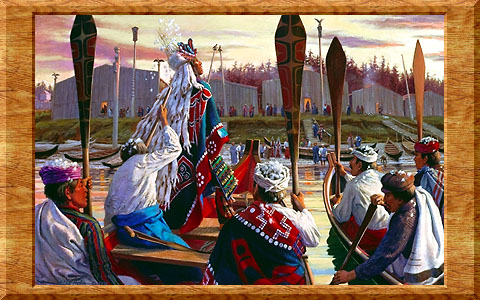
Original acrylic 24" x 36" by Bill Holm © 1991
Collection of Loren Smith
After months of preparation, a Kwakwaka'wakw chief is ready to bring out in a lavish potlatch the noble prerogatives that are being passed to his children. In order to properly validate those privileges, he has invited the people of other villages to act as witnesses. As the invited guests arrive, they assemble their canoes in the winter afternoon light off the shelving beach of the village of Tsakhees ("Water running on the beach", named for the little stream that runs along the base of the bank). While the paddlers sing and beat time on the gunwales of the canoes with their paddles, a dancer wearing the elaborately embellished dancing headdress performs in the bow of the lead canoe, scattering eagle down, signifying peace, from his crown of sealion whiskers. The villagers gather on the beach and on the bank in front of the big, plank houses. The host chief and his speaker prepare to welcome the visitors, while on the beach singers and headdress dancers stand ready to perform a welcoming dance in response to that of their guests.
The village of Tsakhees stood close by the Hudson's Bay Company trading post of Fort Rupert, on the shore of Beaver Harbour on Vancouver Island's north coast. Although the owners of many of these houses owned the privilege of painted house fronts, none of these particular houses had painted fronts in the 1890s, according to photographs of the period. Tsakhees, or Fort Rupert as it is known in English, is still a thriving village today.